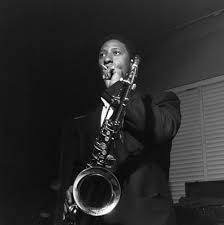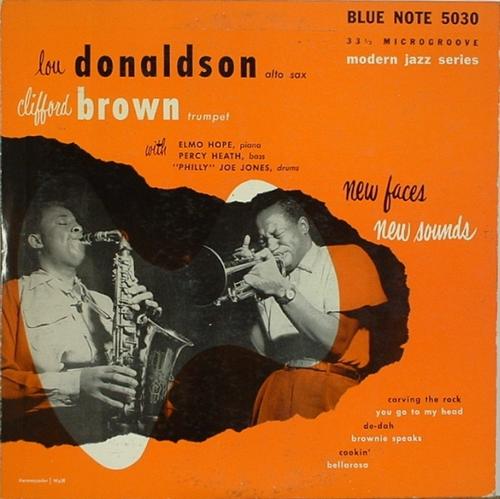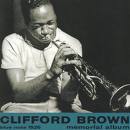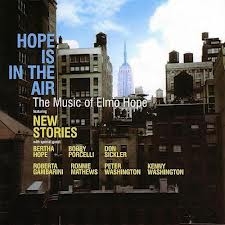Carvin' The Rock – Elmo Hope & Sonny Rollins
A recollection of Elmo & Sonny's stint at Riker's Island ("The Rock"), this unusual composition has an interesting form and a driving rhythm. Three Clifford Brown trumpet solos available, each in both B-flat and C editions. Minus You tracks are also available for all instruments from the "New Stories" recording.
- Recording: Lou Donaldson - Lou Donaldson 10-inch
- Recorded on: June 9, 1953
- Label: Blue Note (BN 5030)
- Concert Key: A-flat
- Vocal Range: , to
- Style: Swing (medium up)
- Trumpet - Clifford Brown
- Alto Sax - Lou Donaldson
- Piano - Elmo Hope
- Bass - Percy Heath
- Drums - Philly Joe Jones
Purchase Carvin' The Rock - Elmo Hope & Sonny Rollins
Purchasing this song through our affiliate links with certain retailers provides jazzleadsheets.com with additional support to help keep us bringing you the best lead sheets available. Thank you!
MASTER
ALTERNATE 1
ALTERNATE 2
Video
- The Music of Elmo Hope: Mike Rodriguez, trumpet; Joe Lovano, tenor sax; Eric Reed, piano; Barak Mori, bass; Kenny Washington, drums; live from Miller Theater, Columbia University, NYC. Eric Reed, producer. 10/12/2001.
- Grant Stewart at Camion Jazz: Grant Stewart, tenor sax; Yves Brouqui, guitar; Nicolas Rageau, bass; Phil Stewart, drums. 2013.
- Description
- Historical Notes
- Solos
- Piano Corner
- Bass Corner
- Drum Corner
- Guitar Corner
- Inside & Beyond
- Minus You
Our recording excerpt starts with the melody. The actual recording begins with an 8-measure drum set up. This composition has an interesting form that is used for the solo section as well. When you examine the lead sheet, you'll see that the last 12-measure section, which comes after the 8 measure bridge, is not a musical repeat of the melody from the beginning, as would be normal in an ABA form. Rather, the last section starts from the 5th measure of the opening melody. As a result, this 16-8-12 measure repeating form seems to just keep going, sounding like it never comes to a end.
This album, the Lou Donaldson 10 inch Blue Note release, was the original release and contained only the master take track.
"The Rock" was what musicians, and others, called Riker's Island, one of New York City's large jail facilities. Drug problems caused quite a few musicians to be detained at "The Rock." The only time Sonny Rollins recalls being detained at Riker's with Elmo was for a portion of 1950, so, if pressed, he feels Carvin' The Rock was written at that time. This would therefore be three years before the recording. There seems to be no word from Elmo as to when this composition was written.
We are fortunate in that the audio for all three recorded takes is available, so you can examine the variations the musicians made from take to take. Clifford Brown's solo from each take is also available separately. Comparing solos from different takes of the same song can give you further valuable insights into the soloist.
For more details about Elmo Hope's recordings, check out the Elmo Hope Discography on Noal Cohen's Jazz History website.
Related Songs
Email Send Carvin' The Rock to a friend
- Recording: Clifford Brown - Clifford Brown Memorial Album
- Recorded on: June 9, 1953
- Label: Blue Note (BLP 1526)
- Concert Key: A-flat
- Vocal Range: , to
- Style: Swing (medium up)
- Trumpet - Clifford Brown
- Alto Sax - Lou Donaldson
- Piano - Elmo Hope
- Bass - Percy Heath
- Drums - Philly Joe Jones
Purchase Carvin' The Rock - Elmo Hope & Sonny Rollins
Purchasing this song through our affiliate links with certain retailers provides jazzleadsheets.com with additional support to help keep us bringing you the best lead sheets available. Thank you!
MASTER
ALTERNATE 1
ALTERNATE 2
- Description
- Historical Notes
- Solos
- Piano Corner
- Bass Corner
- Drum Corner
- Guitar Corner
- Inside & Beyond
- Minus You
"The Rock" was what musicians, and others, called Riker's Island, one of New York City's large jail facilities. Drug problems caused quite a few musicians to be detained at "The Rock." The only time Sonny Rollins recalls being detained at Riker's with Elmo was for a portion of 1950, so, if pressed, he feels Carvin' The Rock was written at that time. This would therefore be three years before the recording. There seems to be no word from Elmo as to when this composition was written.
We are fortunate in that the audio for all three recorded takes is available, so you can examine the variations the musicians made from take to take. Clifford Brown's solo from each take is also available separately. Comparing solos from different takes of the same song can give you further valuable insights into the soloist.
For more details about Elmo Hope's recordings, check out the Elmo Hope Discography on Noal Cohen's Jazz History website.
You'll immediately hear that Clifford had a way he wanted to start his solo. First (alt 1) he tried his opening phrase pattern in the lower octave. On the second take (which became the master take) he started with the same first-measure-notes up an octave, and then immediately went a different direction. At the end of the whole recording session, they decided they wanted to try one more take, which is now alternate take 2. That time, Clifford essentially played the first two measures the same as he did on the master take, with only a couple of minor alterations you'll see when you compare these two transcriptions. Then he headed off in a totally new direction.
Related Songs
Email Send Carvin' The Rock to a friend
- Recording: New Stories - Hope Is In The Air
- Recorded on: April 28, 1998
- Label: Origin (82434)
- Concert Key: A-flat
- Vocal Range: , to
- Style: Swing (medium up)
- Alto Sax - Bobby Porcelli
- Piano - Marc Seales
- Bass - Doug Miller
- Drums - John Bishop
Video
- Description
- Historical Notes
- Solos
- Piano Corner
- Bass Corner
- Drum Corner
- Guitar Corner
- Inside & Beyond
- Minus You
Our lead sheets and rhythm section parts show all the rhythm section activity on the head. Minus You tracks are also available for all instruments; click on the Minus You tab for more details. Parts labeled (minus you) are the basic lead sheets and also the Minus You parts. Tracks labeled (practice) have fewer choruses and would be great for auditions. Tracks labeled (performance) have more solo choruses.
The New Stories trio, a Seattle-based group, took a few weeks off their regular lives to work on Second Floor Music/jazzleadsheets.com music at Rudy Van Gelder's Englewood Cliffs, New Jersey, studio. They had immersed themselves in Elmo Hope music in preparation, and when they met saxophonist Bobby Porcelli in the studio, magic happened.
The magic continued after the musicians went home and we discovered the tracks were suitable for Minus You tracks. Click the Minus You tab for details.
Separate melody and rhythm section parts are available under LEADSHEETS. Any melody part can be used with any minus melody track as well as the trio (bass & drums only) tracks. The Piano part is for any harmonic instrument (Piano, Guitar, Vibes, etc.) and can also be used with either the MP3 minus piano track or the trio (bass & drums only) tracks.
CLIP Format of the full track:
-- melody
-- sax solo 2 choruses
-- piano solo 2 choruses
-- 8s (alto - drums) 1 chorus
-- out melody (piano solos on B)
Because the form is divided into 16-, 8-, and 12-measure sections, in the chorus of trading 8s the last drum solo section is 12 measures long.
mp3 minus melody
-- count off sets up the melody
-- play the melody
-- solo
performance edition: 2 choruses
practice edition: 4 choruses: 2 with full rhythm section, 2 with Bass and Drums
-- trade 8s with drums 1 chorus
-- play the out melody (tacet at B)
mp3 minus Piano The Piano part can also be used with the MP3 trio (bass & drums only) tracks.
-- count off sets up the melody
-- comp/play figures for the melody
-- comp for the alto solo 2 choruses
-- solo 2 choruses
-- comp for alto/drums trading 8s 1 chorus
-- comp/play figures for the out melody (solo at B)
mp3 minus Bass
-- count off sets up the melody
-- walk/play figures for the melody
-- walk for the alto and piano solos (2 choruses each)
-- walk for alto/drums trading 8s 1 chorus
-- walk/play figures for the out melody
mp3 minus Drums - sticks throughout (snaps added on trading)
-- count off sets up the melody
-- comp/play figures for the melody
-- comp for the alto and piano solos (2 choruses each)
-- trade 8s with alto (alto first) 1 chorus clip
-- comp/play figures for the out melody
mp3B ass & Drums only - to feature piano, guitar, vibes, or any melodic instrument that likes to play without harmonic accompaniment
-- count off sets up the melody
-- play the melody
-- solo
performance edition: 2 choruses
practice edition: 4 choruses
-- trade 8s with drums 1 chorus
-- play the out melody
Related Songs
Email Send Carvin' The Rock to a friend
- Recording: Elmo Hope - New Faces-New Sounds: Elmo Hope Trio
- Recorded on: June 18, 1953
- Label: Blue Note (BLP 5029 10" LP)
- Concert Key: A-flat
- Vocal Range: , to
- Style: Swing (uptempo)
- Piano - Elmo Hope
- Bass - Percy Heath
- Drums - Philly Joe Jones
Video
- Description
- Historical Notes
- Solos
- Piano Corner
- Bass Corner
- Drum Corner
- Guitar Corner
- Inside & Beyond
- Minus You
For more details click on Piano Corner and Bass Corner. Our piano and bass parts reflect this arrangement; drummers playing in a trio can read either part.
This Elmo Hope session was only the fourth Blue Note session recorded at Rudy Van Gelder's home studio in Hackensack, New Jersey. "New Faces - New Sounds" was Blue Note's name for sessions by up-and-coming musicians in the early to mid-'50s, including the first three that Rudy recorded before this one: two by saxophonist Gil Melle, who introduced Rudy to producer Alfred Lion, and one by pianist Kenny Drew.
There are several places where Elmo anticipates chords while Percy is still walking; the chord symbols on the bass part are shown right on the beat while they are anticipated in the piano part.
Related Songs
Email Send Carvin' The Rock to a friend
- Recording: Grant Stewart - Estate
- Recorded on: December 8, 2005
- Label: Video Arts (1282)
- Concert Key: A-flat
- Vocal Range: , to
- Style: Swing (medium up)
- Tenor Sax - Grant Stewart
- Guitar - Joe Cohn
- Piano - Ehud Asherie
- Bass - Joel Forbes
- Drums - Phil Stewart
Video
- Description
- Historical Notes
- Solos
- Piano Corner
- Bass Corner
- Drum Corner
- Guitar Corner
- Inside & Beyond
- Minus You
As in the Clifford Brown recording, the piano plays the B section melody, though in this version the tenor sax and guitar play the pickup into B.
Grant has also recorded Elmo Hope's Roll On as the title track of a 2016 trio album on Cellar Live featuring the Stewart brothers (Grant and Phil) with bassist Paul Sikivie.
Just over a year before the recording of "Estate," Joe Cohn recorded on saxophonist Grant Stewart's album "+4." At this point in his career, Cohn had also developed a strong rapport with bassist Joel Forbes, with whom he had played on numerous sessions, as part of the Harry Allen quartet.
This solo is best suited for advanced guitarists looking for a technique workout.
In all, Cohn's performance on Carvin' The Rock is a great study in rhythmic phrasing and articulation for intermediate and advanced guitarists.
Related Songs
Email Send Carvin' The Rock to a friend

Elmo Hope
June 27, 1923 – May 19, 1967
An imaginative pianist who valued subtlety over virtuosity in the landscape of bebop, Elmo Hope never achieved the fame that his close friends did, perhaps because he so rejected stylistic norms of the time. Elmo was a classically trained pianist with technique rivaling that of his childhood friend Bud Powell and a composer of music whose inventiveness and complexity approaches that of Thelonious Monk. In fact, Elmo, Thelonious and Bud used to hang out so much together in the late 1940s they became known as "The Three Musketeers." Powell, in Francis Paudras' book "Dance of the Infidels" is quoted as saying, "You gotta hear Elmo. He's fabulous. His stuff is very hard. He does some things that even I have trouble playing." Read more...

Sonny Rollins
born on September 7, 1930
Tenor saxophone legend Sonny Rollins is without question one of the most important and influential jazz musicians and composers in history. His enduring career has made him both a hallmark of the bebop and hardbop eras and a great contemporary player—and a forefront of every jazz movement in between. Miles Davis himself considered Newk (a nickname inspired by his resemblance to the Brooklyn Dodgers' pitcher Don Newcombe) to be the greatest tenor saxophonist of all time. Read more...








